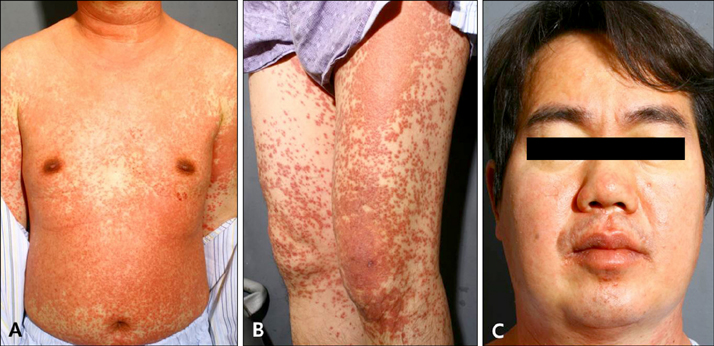Ann Dermatol.
2017 Apr;29(2):206-209. 10.5021/ad.2017.29.2.206.
Drug Reaction with Eosinophilia and Systemic Symptom Syndrome Induced by Lamotrigine
- Affiliations
-
- 1Department of Dermatology, Konkuk University School of Medicine, Seoul, Korea. kjahn@kuh.ac.kr
- KMID: 2394845
- DOI: http://doi.org/10.5021/ad.2017.29.2.206
Abstract
- Drug reaction with eosinophilia and systemic symptom (DRESS) syndrome is a type of severe adverse drug-induced reaction. Dermatologists should make a quick diagnosis and provide appropriate treatment for DRESS syndrome to reduce mortality rates, which can be as high as 10%. We present the case of a 47-year-old man with schizoaffective disorder treated with lamotrigine who developed DRESS syndrome to emphasize the importance of close observation of patients with drug eruption. He was consulted for erythematous maculopapular rashes on the trunk that developed 3 weeks after starting lamotrigine. A few days later, he developed generalized influenza-like symptoms. The skin rashes spread over his entire body, and the sense of itching was rapidly aggravated within a few days. Increased liver enzyme levels and significant eosinophilia were found on laboratory test results. His condition was diagnosed as DRESS syndrome, and he was treated with systemic and topical corticosteroids for 2 weeks.
MeSH Terms
Figure
Reference
-
1. Lee JE, Goo BC, Kim YC, Lee JH, Lee KH. A case of anticonvulsant hypersensitivity syndrome thought to be caused by lamotrigine. Korean J Dermatol. 2006; 44:620–623.2. Knowles SR, Shapiro LE, Shear NH. Anticonvulsant hypersensitivity syndrome: incidence, prevention and management. Drug Saf. 1999; 21:489–501.3. Jeon EK, Lee KM, Kwon YB, Seo YJ, Park JK, Lee JH. Three cases of allopurinol-induced DRESS syndrome. Korean J Dermatol. 2007; 45:714–719.4. Tas S, Simonart T. Management of drug rash with eosinophilia and systemic symptoms (DRESS syndrome): an update. Dermatology. 2003; 206:353–356.
Article5. Ichiche M, Kiesch N, De Bels D. DRESS syndrome associated with HHV-6 reactivation. Eur J Intern Med. 2003; 14:498–500.
Article6. Kim TI, Jeong KH, Shin MK, Kim NI. Piperacillin/Tazobactam-Associated hypersensitivity syndrome with overlapping features of acute generalized exanthematous pustulosis and drug-related rash with eosinophilia and systemic symptoms syndrome. Ann Dermatol. 2016; 28:98–101.
Article7. Schlienger RG, Knowles SR, Shear NH. Lamotrigine-associated anticonvulsant hypersensitivity syndrome. Neurology. 1998; 51:1172–1175.
Article8. Beller TC, Boyce JA. Prolonged anticonvulsant hypersensitivity syndrome related to lamotrigine in a patient with human immunodeficiency virus. Allergy Asthma Proc. 2002; 23:415–419.9. Fervenza FC, Kanakiriya S, Kunau RT, Gibney R, Lager DJ. Acute granulomatous interstitial nephritis and colitis in anticonvulsant hypersensitivity syndrome associated with lamotrigine treatment. Am J Kidney Dis. 2000; 36:1034–1040.
Article10. Kim YH, Choi CW, Lee GY, Kim WS. A case of valproic acid induced DRESS syndrome. Korean J Dermatol. 2012; 50:85–88.11. Bachot N, Roujeau JC. Differential diagnosis of severe cutaneous drug eruptions. Am J Clin Dermatol. 2003; 4:561–572.
Article12. Bessmertny O, Pham T. Antiepileptic hypersensitivity syndrome: clinicians beware and be aware. Curr Allergy Asthma Rep. 2002; 2:34–39.
Article13. Wang XQ, Lv B, Wang HF, Zhang X, Yu SY, Huang XS, et al. Lamotrigine induced DIHS/DRESS: Manifestations, treatment, and outcome in 57 patients. Clin Neurol Neurosurg. 2015; 138:1–7.
Article14. Kim JW, Kim KS. Two cases of stevens-johnson syndrome related to concomitant use of lamotrigine and valproic acid. Korean J Dermatol. 2005; 43:1105–1109.15. Chaiken BH, Goldberg BI, Segal JP. Dilantin sensitivity; report of a case of hepatitis with jaundice, pyrexia and exfoliative dermatitis. N Engl J Med. 1950; 242:897–898.16. Sontheimer RD, Houpt KR. DIDMOHS: a proposed consensus nomenclature for the drug-induced delayed multiorgan hypersensitivity syndrome. Arch Dermatol. 1998; 134:874–876.
Article17. Roujeau JC. Treatment of severe drug eruptions. J Dermatol. 1999; 26:718–722.
Article18. Kardaun SH, Sidoroff A, Valeyrie-Allanore L, Halevy S, Davidovici BB, Mockenhaupt M, et al. Variability in the clinical pattern of cutaneous side-effects of drugs with systemic symptoms: does a DRESS syndrome really exist? Br J Dermatol. 2007; 156:609–611.
Article
- Full Text Links
- Actions
-
Cited
- CITED
-
- Close
- Share
- Similar articles
-
- DRESS (drug reaction with eosinophilia and systemic symptoms) syndrome induced by lamotrigine in a child
- Drug Reaction with Eosinophilia and Systemic Symptom Syndrome Due to Everolimus: A Case Report
- Rasagiline Induced Drug Rash with Eosinophilia and Systemic Symptoms Syndrome: A Case Report
- A Case of Drug Rash with Eosinophilia and Systemic Symptoms Associated with Valproic Acid and Olanzapine Treatment in Patient with Bipolar Disorder
- Drug reaction with eosinophilia and systemic symptom induced in a 9-year-old boy



